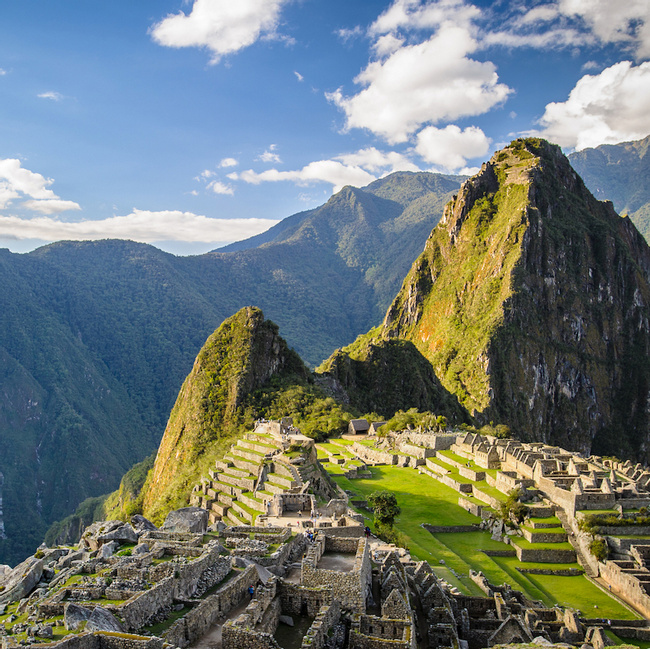- Travel Guides
Religion in Peru
In 1532, the Spanish arrived in the Andes and began their campaign of conversion and colonization. Because of widespread Spanish rule over the following centuries, about 90 percent of the modern Peruvian population identifies as Catholic. But Catholicism in Peru is distinct from Catholicism anywhere else, blending with much older indigenous practices and holidays.

Throughout Peruvian cities and villages, you can stop and admire the cathedrals that the Spanish built, which are close by (and sometimes directly on top of) the ruins of Inca and older indigenous civilizations. For example, Qurikancha, the Incan Temple of the Sun in Cusco, originally shone with a layer of gold, removed by the Spanish conquistadors in the 16th century. Nearly 100 years later, the Spanish completed construction of the Church of Santo Domingo on the ruins of the temple, incorporating walls that Inca had built into the church. You can still see this blended temple today, an architectural metaphor of the history of Peruvian religious practices.
Before the arrival of the Spaniards, the religions of the disparate Peruvian indigenous groups often involved some kind of nature worship. Gods and goddesses typically took the form of anthropomorphized snakes, birds, the sun and the moon, and Mother Earth. What we know of the Inca pantheon of gods and goddesses comes from the archaeology of temples and shrines, and some records preserved by Spanish priests after the conquest. Just as Peruvians now celebrate a version of Catholicism mixed with native beliefs and practices, the Incan religion absorbed some of the central tenets of the cultures the Inca people had conquered.
Like many Andean religions, Inca considered the sun god the most prominent. Called Inti, the Inca rulers considered him their direct ancestor. His wife is Mama Quilla, the goddess of the moon, whose cycles dictated the Inca calendar. Viracocha, another major deity, is depicted as an old man. Inca worshipped him as the creator of all living things, although he is not supposed to have played a major role in daily life. Temples and shrines to these deities still stand, and have become popular tourist destinations.
Before the Inca, the warlike Wari people had a significant presence throughout the Andes. Their religious practices included ritual burning of the skulls of captured peoples. Shrines, such as at the Huaca Pucllana ruin in modern-day Lima, contained mummies buried with ritual offerings. Not much is known of Wari religious life outside of these recent archaeological finds, but the Huaca Pucllana structure is still an active archaeological site. Similarly to the Wari, little is known of the religions of the earlier Moche and Chimu Andean peoples. Based on their art, it is evident that human sacrifice was meant to ensure a sufficient harvest. These themes of sacrifice continued to be an important part of Andean religious life, reborn in the Christian story of Christ’s sacrifice.
The priesthood was an important part of Inca religious structure. Inca rulers relied on priests to tell them what the future held. Shamans used plants and animals as part of divination rituals. To this day, shamans conduct rituals developed well before the colonial era. Using a medicinal plant called ayahuasca, they induce hallucinations as the means to a spiritual journey, one that allows the supplicant to experience profound spiritual revelations.
Inca attributed special spiritual importance to the valley in Urubamba, near Cusco. They called it the Sacred Valley, and its effect transcends time and nationalities. Modern tourists who visit the Sacred Valley feel the same sense of awe, and attribute the sensation to the mystical properties of the valley. This area has become a prominent destination for New Age tourism and a popular spot for meditative retreats.
When the Spanish arrived, their armor and technologically advanced weaponry made it impossible for the natives to drive them away. From the 16th century onward, Catholicism has dominated Peruvian religious life. Peruvians have kept many holidays and traditions from the Inca religious calendar, often celebrating them alongside Christian holidays, but religion is just the tip of the iceberg. Peru's history has made for a rich and vibrant culture overall—a byproduct of the fusion between the indigenous and foreign peoples who grew to call the country home.
It's more than just having a good time or visiting beautiful places (although that's absolutely a part of it!), it's about being part of a unique experience that stays with you.



